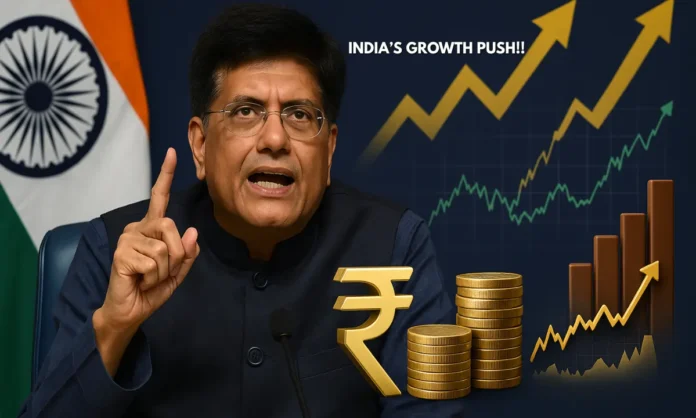SUMMARY
- Piyush Goyal defends Indian economy by citing robust GDP growth, with real GDP rising 6.5 % in FY 2024-25 and nominal GDP soaring nearly threefold since 2014-15.
- Piyush Goyal defends Indian economy by highlighting strong foreign exchange reserves—over US $700 billion in mid-2025—despite recent drops.
- Piyush Goyal defends Indian economy through reference to low inflation (2.82 % in May 2025) and record exports of approximately US $825 billion in FY 2024-25.
Framing India’s Economic Counter-Narrative
Piyush Goyal defends Indian economy by turning the spotlight on compelling macroeconomic figures. Amid criticism from a senior Congress MP labeling the Indian economy as “dead,” Goyal dismissed the remark as “parroting a negative narrative” and affirmed that India’s fundamentals remain strong. He underscored multiple indicators—currency stability, foreign exchange reserves, stock market health, and underlying fiscal resilience—as proof of India’s vitality.
Official figures support this assertion. Real GDP grew by 6.5 % in FY 2024-25, the fastest among major economies. Nominal GDP has climbed from approximately ₹106.57 lakh crore in 2014-15 to ₹330.68 lakh crore in 2024-25, representing a near threefold increase. In the final quarter alone, real GDP surged 7.4 % and nominal GDP expanded 10.8 %, illustrating accelerating momentum.
#BREAKING: India’s Commerce Minister @PiyushGoyal takes a strong stand inside Indian Parliament reacting to Trump Tariffs giving utmost priority to safeguarding welfare of farmers, labourers, entrepreneurs, industrialists, exporters, MSMEs & stakeholders of the industrial sector. pic.twitter.com/RC74Wnf4zm
— Aditya Raj Kaul (@AdityaRajKaul) July 31, 2025
Global Confidence Through Strong Reserves
A key pillar of Piyush Goyal defends Indian economy was his reference to India’s foreign exchange reserves. These reached US $702.8 billion as of late June 2025. Although they dipped to around US $688.9 billion by early August, the decline was attributed to strategic Reserve Bank of India intervention to defend the rupee amid external shocks, including newly announced U.S. tariffs. Even with the reduction, reserves were still sufficient to cover around 11 months of merchandise imports, demonstrating external stability.
Beyond sheer size, Piyush Goyal defends Indian economy by pointing to qualitative improvements in reserve composition. Gold holdings now comprise 12.1 % of the total as of mid-July 2025, up from 8.9 % a year earlier, reflecting a deliberate diversification strategy aimed at hedging against currency volatility.
Stability in Currency and Inflation Trends
When Piyush Goyal defends Indian economy, he accentuates the rupee’s resilience. Despite the pressure from new U.S. tariffs, the rupee traded steadily at around ₹87.72–₹87.73 per U.S. dollar in early August, aided by targeted market interventions and steady investor sentiment.
Another critical indicator in his argument is inflation. Piyush Goyal defends Indian economy by noting that consumer price inflation in May 2025 was just 2.82 %, the lowest recorded since February 2019. Such low inflation signals effective price stability measures and offers a cushion for household budgets, enhancing consumer confidence.
Trade, Exports, and Digital Dynamism
Beyond macroeconomic stability, Piyush Goyal defends Indian economy by underscoring its robust trade performance. In FY 2024-25, total exports reached an all-time high of US $824.9 billion, indicating strong global demand for Indian goods and services.
He also outlined ongoing negotiations for new trade agreements with partners including the UAE, UK, EU, US, Australia, and the EFTA bloc, as well as Chile, Peru, and New Zealand. These initiatives are positioned as part of a broader strategy to expand market access and solidify India’s role in global supply chains.
Piyush Goyal defends Indian economy further by referencing demographic and technological strengths. India’s population of 1.4 billion, with a large share of young and skilled individuals, is an attractive prospect for international investors. The IT sector’s capacity to innovate and adapt—demonstrated vividly during the Covid-19 pandemic—has been a key driver of job creation and productivity gains.
Looking Ahead: Opportunity in Resilience
Finally, Piyush Goyal defends Indian economy by setting forth an optimistic vision for the future. He stressed that India has consistently emerged stronger from challenging situations, citing both the post-2000 transformation and the country’s agility during the pandemic.
The upcoming years are expected to bring a wave of trade deals, increased manufacturing activity under initiatives like “Make in India,” and deeper integration with global economic networks. With strong fundamentals, a growing workforce, and active trade diplomacy, Piyush Goyal defends Indian economy as not just stable but primed for accelerated growth in the evolving global order.


